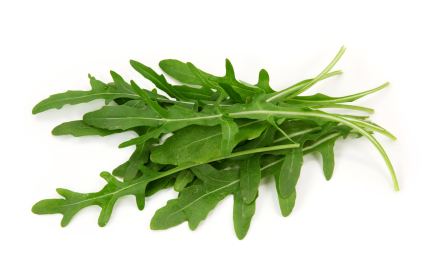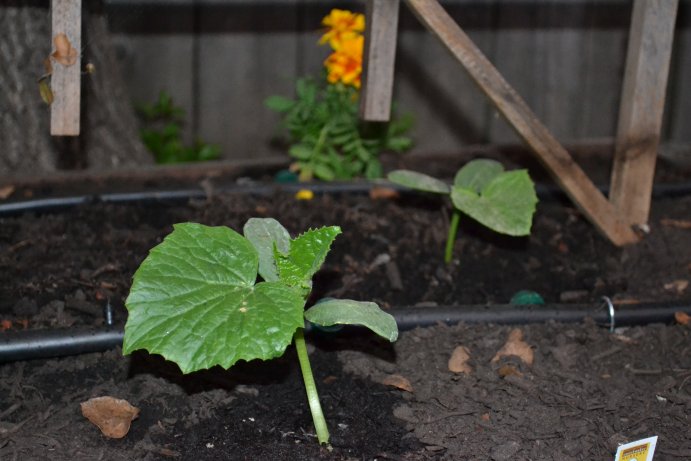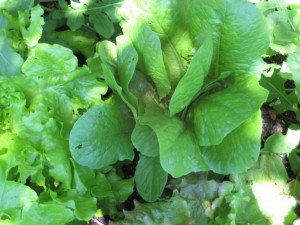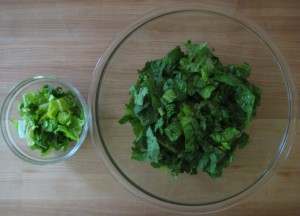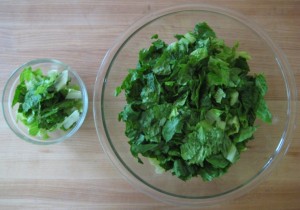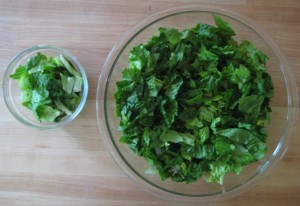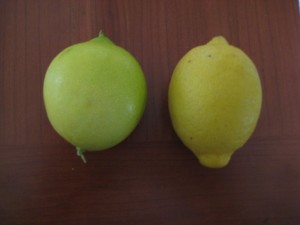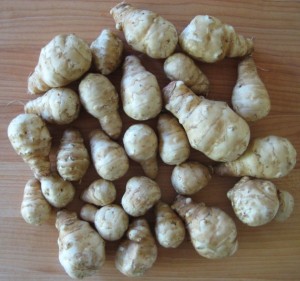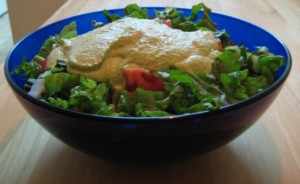Years ago, when I started to become interested in health and nutrition, I became acquainted with arugula by accident. At the time, admittedly I was not very well educated about leafy greens, given that iceberg lettuce and spinach formed the boundaries of my leafy green literacy.
One day, in produce area of my local natural food store, I bagged several heads of lettuce, finished my shopping and returned home. Later, while making a salad, I discovered that I had mistakenly purchased one bunch of arugula leaves instead of a head of lettuce. I tried it and found that I really liked the mildly spicy flavor. Nowadays, I enjoy arugula occasionally in my salads and smoothies. I especially find arugula to be a salad-friendly leafy green due to the mildly spicy taste and tenderness of the leaf, unlike stronger tasting and more fibrous leafy greens.
Arugula is a member of the cabbage family, making it a botanical relative of kale, broccoli, cauliflower, bok choy, and cabbage. Like many other members of this plant family, the mineral content of arugula is significant, especially calcium:
| Arugula – 4 cups chopped | Adult Daily Values | |
| Calories | 20 | |
| Calcium | 128.0 | 1000 – 1200 mg |
| Iron | 1.17 | 8 – 18 mg |
| Zinc | 0.38 | 8 – 11 mg |
| Magnesium | 37.6 | 310 – 420 mg |
| Potassium | 295.2 | 4700 mg |
Considering that 4 cups of arugula contains 20 calories, the content of the nutrients listed above are notable. This sample of arugula also contains 77.6 mcg of folate and 2.06 g of protein.
The arugula plants growing in my yard recently flowered:
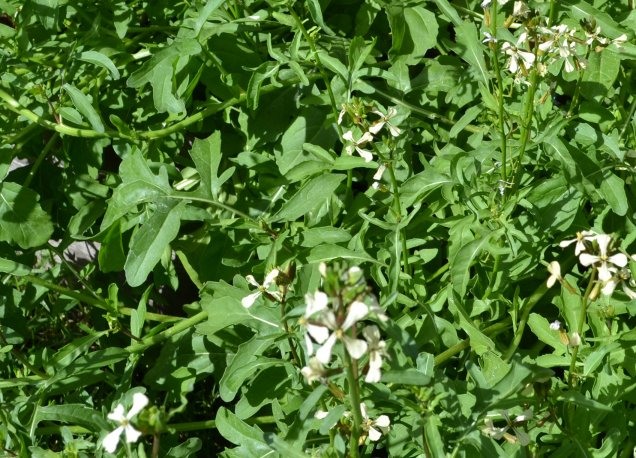
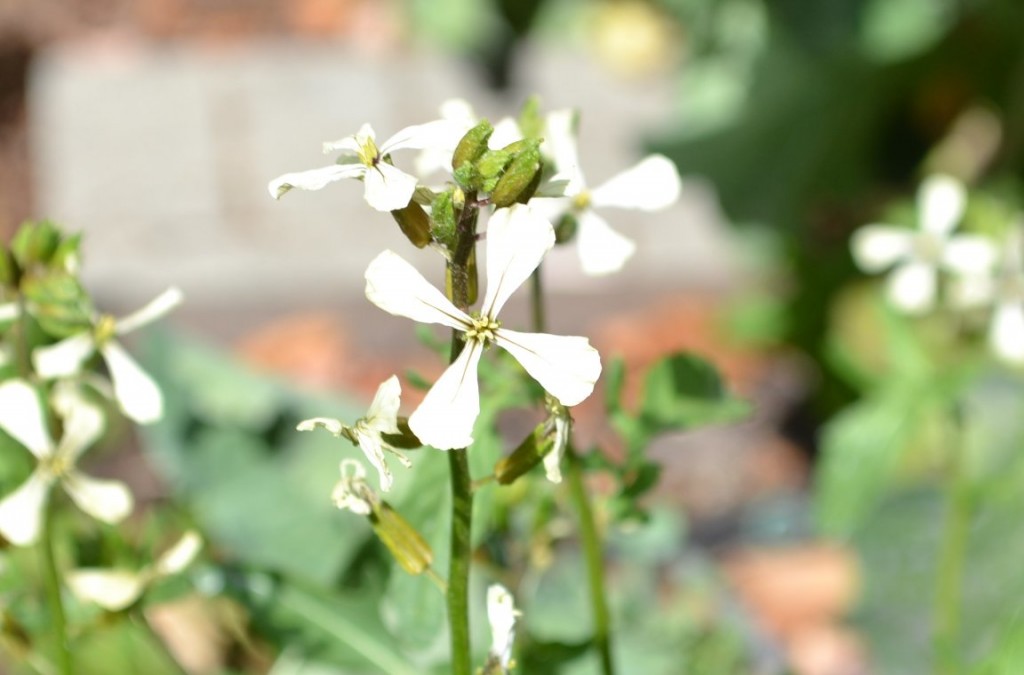
One of the best ways to keep in touch with us is to join our email list. You’ll receive a free copy of Our Top 12 Strategies for Long Term Success on A Raw Plant-Based Diet eBook along with regular information about raw food and plant-based diets and periodic promotions for our classes, events, and other offerings!
Basil – beautiful, aromatic, and nutrient dense?
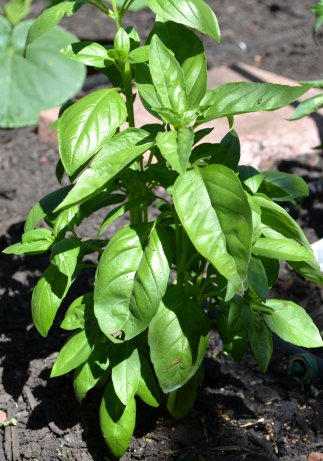 Rick and I returned home after being out of town for almost two weeks to find that many of plants in our garden had almost tripled in size, especially our basil plants. I love basil. I love the taste. I love the fragrance. I love how well it grows in my garden, etc. And, I am amazed by its calcium content:
Rick and I returned home after being out of town for almost two weeks to find that many of plants in our garden had almost tripled in size, especially our basil plants. I love basil. I love the taste. I love the fragrance. I love how well it grows in my garden, etc. And, I am amazed by its calcium content:
| Basil – ½ cup chopped fresh | Adult Daily Values | |
| Calories | 21.2 | |
| Calcium | 37.5 | 1000 – 1200 mg |
| Iron | 0.67 | 8 – 18 mg |
| Magnesium | 13.6 | 310 – 420 mg |
| Potassium | 66.5 | 4700 mg |
I enjoy basil in my salads and lots of other dishes that I make. I often use about ½ cup chopped fresh basil in my salads, which can provide a contributory amount of calcium, and other nutrients to my diet. Considering that ½ cup of chopped fresh basil has a little over 21 calories, the amounts of the minerals listed above per calorie is notable.
Basil is a member of the mint family, also known as the Lamiaceae. Other members of the mint family include peppermint, spearmint, lemon balm, oregano, marjoram, rosemary, etc. I have grown numerous members of the mint family, and from my experience, many of these plants can grow and spread rather prolifically. Therefore, I currently grow mint family plants in containers to keep them from spreading throughout my garden. In my garden, I have found that basil does not spread as much as other mint family plants, so I grow it alongside my tomatoes.
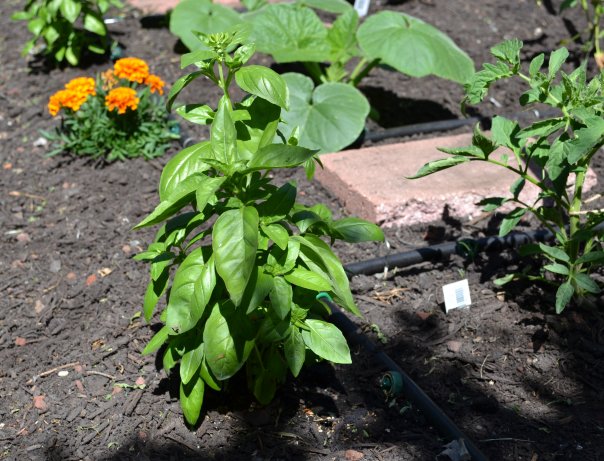
There are many types of basil that I have grown in past years including: Thai basil, cinnamon basil, and my all-time favorite, sweet basil. Here is a photo of our raw food recipe for sweet basil with spiralized zucchini and marinara sauce:
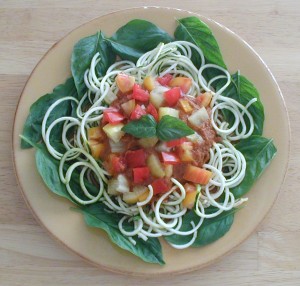
Here is the recipe:
Marinara Sauce (one serving)
2 medium fresh tomatoes (2 cups chopped)
6 soaked sun dried tomatoes (1 ounce dry or 28.3 g)
½ tsp. dried oregano or other Italian spices
1 medjool or other type of date
¼ ripe avocado
Blend fresh tomatoes, spices, date, and avocado in blender, then add soaked sundried tomatoes and blend until smooth. For a lower fat recipe, leave out avocado. For garlic lovers, add ¼ clove of fresh garlic.
Zucchini pasta
To make zucchini pasta, we used a vegetable spiralizer. In general, for spiralizing, we like to use squash or zucchini that is younger in order to create softer noodles. We added the noodles to a bed of sweet basil and topped with marinara sauce, chopped bell pepper, and chopped heirloom tomato.
One of the best ways to keep in touch with us is to join our email list. You’ll receive a free copy of Our Top 12 Strategies for Long Term Success on A Raw Plant-Based Diet eBook along with regular information about raw food and plant-based diets and periodic promotions for our classes, events, and other offerings!
The Often Overlooked Cucumber
Admittedly, I am biased - I am a huge fan of cucumbers. I love their delicate flavor, their watery consistency, and their culinary versatility. Cucumbers make regular appearances in my green juices, salads, and other recipes. English and Japanese cucumbers are my favorites for making spiralized vegetable pasta, along with zucchini and gold bar squash, whereas slicing cucumbers are mainstays in my green juice recipes. Last weekend, I planted three of my favorite varieties of cucumbers in our garden: English, Japanese and lemon cucumbers:
Many of our Science of Raw Food nutrition students have mentioned that they have thought of cucumbers as being a “filler” ingredient in juices and recipes, and not a nutrition powerhouse. Judge for yourself, here is a nutrient analysis of one 8 ¼” long cucumber:
| One cucumber | Adult Daily Values | |
| Calories | 45 | |
| Calcium | 48.2 | 1000 – 1200 mg |
| Iron | 0.85 | 8 – 18 mg |
| Zinc | 0.60 | 8 – 11 mg |
| Magnesium | 39.1 | 310 – 420 mg |
| Potassium | 442.5 | 4700 mg |
| Protein | 1.96 g |
Considering that one cucumber is only 45 calories, the nutrient per calorie ratio for the nutrients stated above is definitely notable, particularly for both calcium and potassium.
When I make green juice, I generally use 3 large cucumbers in addition to the other ingredients:
| Three 8 ¼” cucumbers | Adult Daily Values | |
| Calories | 135.5 | |
| Calcium | 144.5 | 1000 – 1200 mg |
| Iron | 2.53 | 8 – 18 mg |
| Zinc | 1.81 | 8 – 11 mg |
| Magnesium | 117.4 | 310 – 420 mg |
| Potassium | 1327.4 | 4700 mg |
| Protein | 5.87 g |
The amount/percentage of these nutrients that actually makes it into the juice is not yet known, but I am looking forward to seeing studies done on the nutrient content of fresh juice versus the ingredients used to make the juice sometime in the future. This would be great information for juicing enthusiasts to know! Until then, I will continue to enjoy my green juice.
For one of my green juice recipes, see the celery post on this blog.
One of the best ways to keep in touch with us is to join our email list. You’ll receive a free copy of Our Top 12 Strategies for Long Term Success on A Raw Plant-Based Diet eBook along with regular information about raw food and plant-based diets and periodic promotions for our classes, events, and other offerings!
Bok Choy: Minerals and More…
I have been a huge fan of bok choy for many years, especially after I saw the nutrient content of this lovely leafy green:
| Bok choy – 3 cups chopped | Adult Daily Values | |
| Calories | 27.30 | |
| Calcium | 220.5 | 1000 – 1200 mg |
| Iron | 1.68 | 8 – 18 mg |
| Zinc | 0.40 | 8 – 11 mg |
| Magnesium | 39.9 | 310 – 420 mg |
| Potassium | 529.2 | 4700 mg |
| Folate | 138.6 | 400 mcg |
| Vitamin C | 94.5 | 75 – 90 mg |
| Protein | 3.15 |
Three cups of bok choy contains notable amounts of calcium, vitamin C, folate, and potassium. The calcium content of bok choy is exceptional among leafy greens and plant foods in general.

Bok choy is a member of the cabbage plant family, also known as the Brassicaceae. Other members of this plant family include kale and broccoli, which are also known for their notable calcium content. The cabbage family used to be known as the Cruciferae, which was originally named for the cross-like appearance of the flower petals among members of this plant family.
The bok choy plants growing in our yard recently flowered:
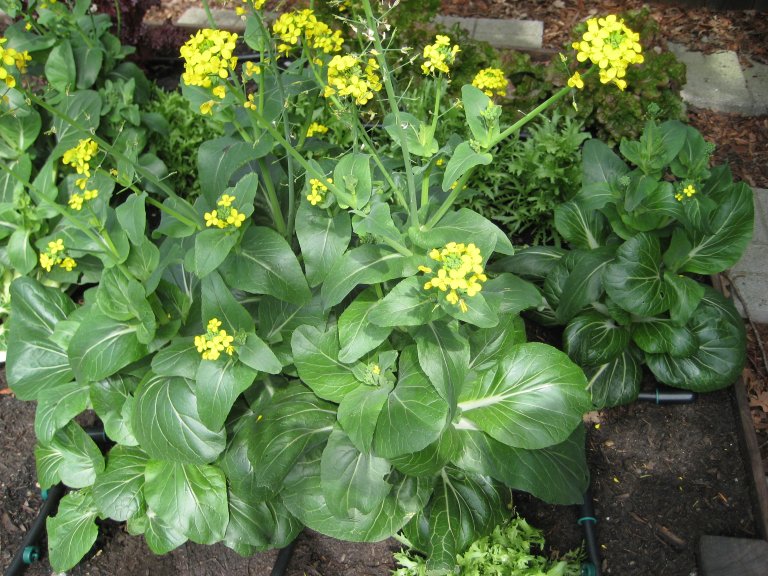
Here is a close-up photo of a bok choy flower:
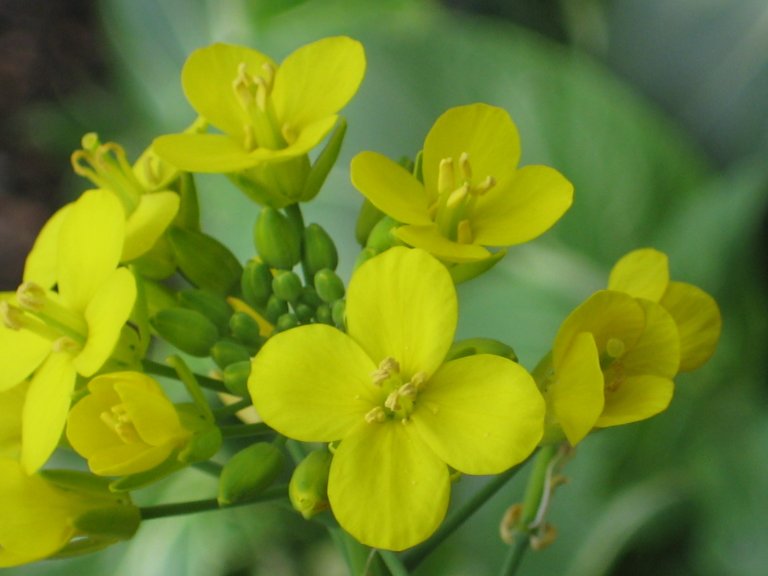
One of the best ways to keep in touch with us is to join our email list. You’ll receive a free copy of Our Top 12 Strategies for Long Term Success on A Raw Plant-Based Diet eBook along with regular information about raw food and plant-based diets and periodic promotions for our classes, events, and other offerings!
Nutrient content of ….. celery? But isn’t celery kind of, well, …. wimpy?
I am always on the lookout for high nutrient-containing foods and was pleased to see that celery is not as lackluster as its former reputation may imply. Actually, celery is one of my favorite green juice ingredients, due to its high water content and slightly salty flavor.
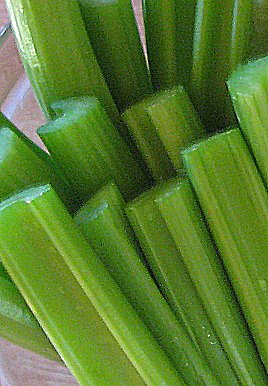
I was surprised to see the calcium content of celery:
| Celery – 3 cups | Adult Daily Values | |
| Calories | 48.5 | |
| Calcium | 121.2 | 1000 – 1200 mg |
| Iron | 0.61 | 8 – 18 mg |
| Zinc | 0.39 | 8 – 11 mg |
| Magnesium | 33.3 | 310 – 420 mg |
| Potassium | 787.8 | 4700 mg |
Three cups of celery has a noteworthy amount of calcium and potassium, with contributory amounts of iron, zinc, and magnesium. Three cups of celery also contains 242 mg of sodium, which is significant for a whole natural plant food.
It is not unusual for me to eat 2-3 cups of chopped celery in my evening salad or even more in my green juice. Here is a jumbo light green juice recipe that makes almost 5 cups of juice:
8 stalks of celery (12” long)
1 lemon, peeled
3 medium cucumber, 8” long
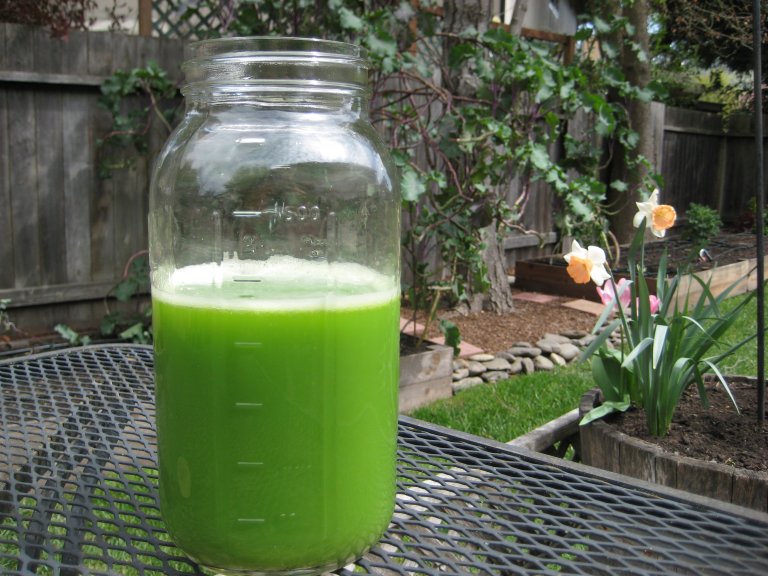
I have found that this recipe is a great way to introduce people to green juice, due to its light, lemony flavor. Here is the nutrient content of the ingredients used to make this juice:
| Jumbo Light Green Juice | Adult Daily Values | |
| Calories | 241 | |
| Calcium | 371 | 1000 – 1200 mg |
| Iron | 4.1 | 8 – 18 mg |
| Zinc | 2.5 | 8 – 11 mg |
| Magnesium | 180.4 | 310 – 420 mg |
| Potassium | 2774.5 | 4700 mg |
| Protein | 10.3 grams |
The nutrient content of the ingredients used to make this amount of juice is considerable, especially calcium, magnesium, potassium, and protein. Of course, adding some dark leafy greens would increase the nutrient content even more significantly. There are several other green juice recipes available on this blog that contain dark leafy greens, such as the Green Giant and Dark Green Juice.
One of the best ways to keep in touch with us is to join our email list. You’ll receive a free copy of Our Top 12 Strategies for Long Term Success on A Raw Plant-Based Diet eBook along with regular information about raw food and plant-based diets and periodic promotions for our classes, events, and other offerings!
March Into April Green Juice
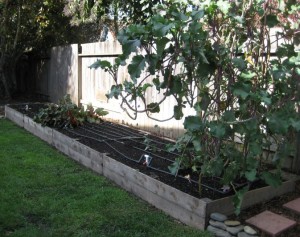 Whew! Rick and I recently returned from teaching 17 days in a row! As always, it was a joy to teach our information to such a fun and enthusiastic group of students. After a short rest, we are now in the process of preparing our raised beds for planting. Here is a photo of our beds filled with compost, awaiting the arrival of new starts:
Whew! Rick and I recently returned from teaching 17 days in a row! As always, it was a joy to teach our information to such a fun and enthusiastic group of students. After a short rest, we are now in the process of preparing our raised beds for planting. Here is a photo of our beds filled with compost, awaiting the arrival of new starts:

We still have some frisée greens growing in our beds, so I made a green juice with them and some ingredients from our local natural food market:
7 stalks of celery (12” long)
1 lemon, peeled
1 medium cucumber, 8” long
4 cups frisée greens
Here are some of the nutrients found in these ingredients:
| Green Juice Ingredients | Adult Daily Values | |
| Calories | 175 | |
| Calcium | 353 | 1000 – 1200 mg |
| Iron | 3.9 | 8 – 18 mg |
| Zinc | 2.8 | 8 – 11 mg |
| Magnesium | 125 | 310 – 420 mg |
| Potassium | 2351 | 4700 mg |
| Protein | 8.5 g |
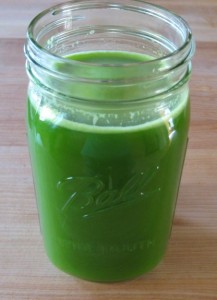
One of the best ways to keep in touch with us is to join our email list. You’ll receive a free copy of Our Top 12 Strategies for Long Term Success on A Raw Plant-Based Diet eBook along with regular information about raw food and plant-based diets and periodic promotions for our classes, events, and other offerings!
Your Questions, Comments, and Emails
After we sent out our last newsletter, we received many questions, comments, and emails. Right now we are teaching our Science of Raw Food Nutrition classes and will be able to answer your questions and emails as time permits. Thank you for all of your kind words about our blog and newsletter and we look forward to bringing more of this type of information to you in the future!
Best of Health,
Drs. Rick and Karin Dina, D.C.
Dandelion Greens
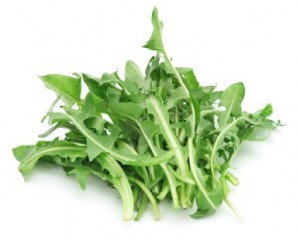 The days are getting longer, the weather is getting warmer, and flowers are starting to bloom in our area of northern California. These are sure signs that spring will be here shortly. One of the many things that I appreciate about spring is the availability of spring greens from my local farmer’s market, natural food store, and my own backyard garden. One popular ingredient in spring green mixes is dandelion greens. I personally love dandelion greens year round, and enjoy them in my salads, smoothies, and juices. I especially appreciate dandelion greens when they are young, since their flavor is less bitter than when they are more mature. Dandelion greens are in the sunflower plant family (Asteraceae), along with lettuce, endive, escarole, frisée greens, sunflower seeds, and Jerusalem artichokes. The name for this plant has an interesting origin. I remember from a college botany class that the name “dandelion” was derived from the French “dent de lion” meaning “tooth of the lion” or “lion’s tooth”, due to the somewhat jagged tooth-like appearance of dandelion greens. The mineral content of dandelion greens is notable:
The days are getting longer, the weather is getting warmer, and flowers are starting to bloom in our area of northern California. These are sure signs that spring will be here shortly. One of the many things that I appreciate about spring is the availability of spring greens from my local farmer’s market, natural food store, and my own backyard garden. One popular ingredient in spring green mixes is dandelion greens. I personally love dandelion greens year round, and enjoy them in my salads, smoothies, and juices. I especially appreciate dandelion greens when they are young, since their flavor is less bitter than when they are more mature. Dandelion greens are in the sunflower plant family (Asteraceae), along with lettuce, endive, escarole, frisée greens, sunflower seeds, and Jerusalem artichokes. The name for this plant has an interesting origin. I remember from a college botany class that the name “dandelion” was derived from the French “dent de lion” meaning “tooth of the lion” or “lion’s tooth”, due to the somewhat jagged tooth-like appearance of dandelion greens. The mineral content of dandelion greens is notable:
| 4 cups chopped dandelion greens (220 g) | Adult Daily Values | |
| Calories | 99 kcal | |
| Calcium | 411.40 | 1000 – 1200 mg |
| Iron | 6.82 | 8 – 18 mg |
| Zinc | 0.90 | 8 – 11 mg |
| Potassium | 873.4 | 4700 mg |
| Magnesium | 79.2 | 310 – 420 mg |
As one can see, the leaves of this plant that is often regarded as a garden weed, actually has significant nutritional value! Additionally, the protein content of 4 cups of chopped dandelion greens is almost 6 grams.
One of the best ways to keep in touch with us is to join our email list. You’ll receive a free copy of Our Top 12 Strategies for Long Term Success on A Raw Plant-Based Diet eBook along with regular information about raw food and plant-based diets and periodic promotions for our classes, events, and other offerings!
Why Raw Works: The Food and Beauty Connection
By Dr. Karin Dina, D.C. and Cherie Soria
Health. Beauty. Youth. We all want them, and some people are willing to do whatever it takes to get them. Keeping people looking young is a billion-dollar industry, but looks aren’t everything. In fact, looks can be deceiving. Lots of things can make one look younger, and even more beautiful, but what can actually make you feel younger? What can actually turn back the hands of time and reverse your physiological age?
There are many keys to achieving a more naturally youthful appearance, brighter eyes, a clearer complexion, more supple skin, shinier hair, stronger nails, a sharper memory, or a more positive outlook on life. Some people claim yoga is the key. Others say meditation. Still others swear by their favorite natural cosmetics, structured water, or exotic superfoods. In reality, a variety of products, practices, and lifestyle choices may work together synergistically, and the mix differs for each individual. The good news is that taking any one positive action to look and feel younger often starts a chain reaction that improves other areas, as well.

But of all the actions one can take to look younger, feel more vibrant and joyful, and have clear beautiful skin, one thing stands out among the rest—raw plant foods.
Raw works! Here’s why:
Whole, fresh, raw natural plant foods contribute nutrients important for clear skin, vivid eyesight, a sharp mind, and radiant health as we age. Many of these act as antioxidants, helping protect our cells from free radicals (highly reactive molecules that contain unpaired electrons, which can damage cells and cause premature aging). Let’s look at a few.

Antioxidants
Noteworthy antioxidants include the anthocyanins found in blue or purple foods such as blueberries, blackberries, and black mission figs. Vanillin, found in vanilla beans, also contains antioxidant properties. Isothiocyanates are plentiful in cruciferous vegetables such as collard greens, kale, bok choy, broccoli, and Napa cabbage.
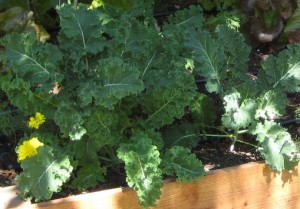
Research shows that increased intake of the antioxidants lutein and zeaxanthin (abundant in dark green leafy cruciferous vegetables and yellow-orange foods like squash, peaches, sweet potatoes, and carrots) may be associated with decreased risk for age-related macular degeneration in the elderly (Stahl, 2005). These substances can also be found in concentrated amounts in the macula of the human eyeball, which is involved in tasks associated with central vision, including reading, driving, and viewing objects straight ahead. They may also play a role in protecting the macula from damage caused by sunlight-induced free radicals. At this point, no recommended dietary intake values are established for lutein and zeaxanthin, but we should still make sure to get an adequate supply.
Vitamin C
Vitamin C plays numerous vital roles in the body, including the formation of collagen. Collagen is a strong, elastic protein-based substance that makes up connective tissue within our bodies and is also a component of cartilage, bone, teeth, muscle tissue, and skin. Without adequate vitamin C, these tissues can be weak and may not function properly. Damage to collagen in the skin can result in wrinkles. Research has noted that people who consume higher amounts of vitamin C have lower risk for several chronic diseases, including eye diseases, cancer, and neurodegenerative conditions (Jacob et al. 2002). This effect can largely be attributed to the antioxidant capacity of vitamin C, along with the more healthful diet and lifestyle that often accompany increased intake of foods that are rich in vitamin C.

Vitamin C is an essential nutrient our bodies do not make, so we must obtain it from our foods. A diet rich in fruits and vegetables can provide us a significant amount of vitamin C. Depending on the foods included, the vitamin C content of most raw food menus can range from about 500 mg to more than 1,800 mg per day, well above the RDA values. Good sources of vitamin C include red bell peppers, kiwi, strawberries, broccoli, cauliflower, kale, papaya, mustard greens, lemons, tomatoes, cantaloupe, romaine lettuce, and of course, oranges.
Essential fatty acids
Research suggests that standard western diets are low in omega 3 fatty acids (Simopoulos, 2008). These fats are essential to good health and critically important for optimal brain function, visual acuity, and many other common heath and age-related issues, including healthy skin. Omega 6 fats, on the other hand, are found in a large variety of foods. One’s diet may contain too many omega 6 fats if the diet includes land animal products and snack foods containing oils from corn, cottonseed, soybean, sesame, sunflower, safflower, and peanuts. Because the average American eats a diet high in these foods, and low in fruits and vegetables (especially leafy greens), they may get an overabundance of omega 6 fats compared to omega 3 fats.
An excess of omega 6s over omega 3s contributes to an excess of inflammation and inflammatory conditions such as arthritis, but may also contribute to degenerative diseases such as heart disease, stroke, and other age-related diseases (Schwalfenberg, 2006).
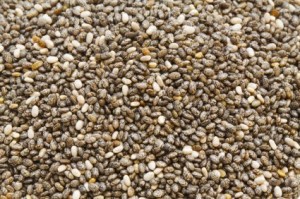
Chia seeds
Small amounts of omega 3 fats are found in almost all fruits and vegetables, although it is difficult to eat enough calories from those foods alone, without including good amounts of green leafy vegetables and certain seeds, like chia, flax, and hemp. One can move toward the correct balance between omega 3 and omega 6 fats by consuming good amounts of leafy green vegetables such as romaine lettuce, kale, dandelion greens, and seeds like chia, flax, and hemp, while cutting down on land animal foods, processed foods, and some oils. DHA supplementation may be important for some people, and plant-based supplements (made from a specific type of algae) are available from several companies (Bradbury, 2011). For more information on omega 3s, including conversion to DHA in the human body, please click here.

Selenium
The mineral selenium also contributes to antioxidant activity in the body. It is also essential for the production of thyroid hormone and proper immune system function. By far the richest food source of selenium is Brazil nuts; a single 5-gram Brazil nut contains 174% of the recommended dietary allowance of this mineral. No other food, in any category, even comes close.

Wild rice
Zinc
Along with vitamin C and selenium, zinc plays an integral role in skin health. It is involved in skin cell growth and replication, collagen synthesis, DNA formation, and immune system function. It is also involved in our ability to taste and smell. Plant food sources of zinc include pumpkin seeds, sesame seeds, wild rice, sunflower seeds, pine nuts, cashews, and lentils.
Raw Foods for Health and Beauty
Here is an expanded list of the healthy plant foods discussed in this article.
- Deeply colored foods high in phytonutrients and antioxidants that combat free-radical damage and promote eye health. Examples include blue or purple foods such as blueberries, blackberries and black mission figs; cruciferous green vegetables such as collard greens, kale, spinach, Swiss chard, dandelion greens, beet greens, bok choy, many lettuces, broccoli, and Napacabbage; yellow-orange fruits and vegetables such as squashes, peaches, sweet potatoes, and carrots; as well as red bell peppers, beets, zucchini, and vanilla beans.
- Foods high in vitamin C, such as lemons, oranges, grapefruit, peaches, strawberries, pineapples, mangos, papaya, kiwi, cantaloupe, broccoli, cauliflower, Brussels sprouts, tomatoes, bell peppers, romaine lettuce, kale, and mustard greens.
- Foods containing omega 3 fatty acids, such as chia, flax, and hemp seeds and dark green leafy vegetables lime kale, romaine, and dandelion greens. DHA from plant-based sources (algae).
- Foods containing selenium, particularly Brazil nuts.
- Foods containing zinc, such as pumpkin seeds, sesame seeds, wild rice, sunflower seeds, pine nuts, cashews, and lentils.
- Hydrating foods, such as juicy fruits, high-water-content vegetables, and of course pure drinking water.
They say beauty is as beauty does. This can mean that inner beauty is more important than outer beauty, or it can mean that our lifestyle, including the foods we eat, has a direct impact on our beauty potential (often expressed as “you are what you eat”). In our opinion, both are true. Develop your outer beauty through your lifestyle and your inner beauty by being a beautiful person. Together they create a beautiful life!
That’s what we really want.
References:
Bradbury J. Docosahexaenoic Acid (DHA): An Ancient Nutrient for the Modern Human Brain. Nutrients. 2011 May;3(5):529-54.
Brown K, Arthur J. Selenium, selenoproteins and human health: a review. Public Health Nutr. 2001;4(2B):593-9.
Guyton, A. Textbook of Medical Physiology, 8th Edition.Philadelphia,PA: W.B. Saunders Company, 1991.
Groff JL and Gropper SS. Advanced Nutrition and Human Metabolism, 3rd Edition.Belmont,CA:Wadsworth Thomson Learning, 2000.
Kleiner S. Water: an essential but overlooked nutrient. J Am Diet Assoc. 1999;99(2):200–6.
Krinsky N, Landrum J, Bone R. Biologic mechanisms of the protective role lutein and zeaxanthin in the eye. Annu Rev Nutr 2003;23:171–201.
Jacob R, Sotoudeh G. Vitamin C function and status in chronic disease. Nutr Clin Care 2002;5(2):66–77.
Porrini M. Functional foods: from theory to practice. Int J Vitam Nutr Res. 2008;78(6):261–8.
Seeram N, Adams L, Zhang Y, Lee R, Sand D, Scheuller H, Heber D. Blackberry, black raspberry, blueberry, cranberry, red raspberry, and strawberry extracts inhibit growth and stimulate apoptosis of human cancer cells in vitro. J Agric Food Chem. 2006;54(25):9329–39.
Semba R. and Dagnelie G. Are lutein and zeaxanthin conditionally essential nutrients for eye health? Med Hypotheses 2003;61(4):465–72.
Sharp R. Role of whole foods in promoting hydration after exercise in humans. J Am Coll Nutr. 2007;26(5 Suppl):592S–596S.
Shyamala B, Naidu M, Sulochanamma G, Srinivas P. Studies on the antioxidant activities of natural vanilla extract and its constituent compounds through in vitro models. J Agric Food Chem. 2007;55(19):7738–43.
Soria C, Davis B, Melina V. The Raw Food Revolution Diet.Summertown ,TN: Book Publishing Company, 2008.
Stahl W. Macular carotenoids: lutein and zeaxanthin. Dev Opthalmol 2005;38:70–88.
One of the best ways to keep in touch with us is to join our email list. You’ll receive a free copy of Our Top 12 Strategies for Long Term Success on A Raw Plant-Based Diet eBook along with regular information about raw food and plant-based diets and periodic promotions for our classes, events, and other offerings!
What is in your salad?
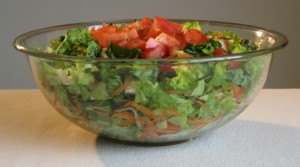 Or more specifically, what is in our salad. 🙂 Here are the ingredients and nutrients found in a super-sized salad with dressing that Rick and I enjoy regularly. We like to change the ingredients in the salad and use different dressings for variety.
Or more specifically, what is in our salad. 🙂 Here are the ingredients and nutrients found in a super-sized salad with dressing that Rick and I enjoy regularly. We like to change the ingredients in the salad and use different dressings for variety.
Garden Vegetable Salad
Romaine lettuce – 8 cups ripped
Frisée greens – 3 cups chopped
Dandelion greens – 4 cups chopped
Jerusalem artichokes – 1 cup peeled and sliced
Tomato – 1 cup chopped
Cucumber – 1 cup chopped
Carrots – 1 cup grated
Combine ingredients in a large bowl.

Salad Dressing Recipe
Lemon juice – 2 tablespoons fresh squeezed
Yellow summer squash – 1 ½ cups chopped
Red bell pepper – ¼ cup chopped
Almonds – 2 tablespoons
Sesame seeds, unhulled – 1 tablespoon
Chia seeds – 1 teaspoon
Pour lemon juice into a blender, such as a Vita-Mix, add chopped squash and red bell pepper. Blend until smooth. Add almonds and sesame seeds and once again, blend until smooth. Add chia seeds to mixture and blend until smooth.
| Salad + Dressing | Adult Daily Requirements | |
| Calories | 611 | |
| Protein | 27.26 g | |
| Vitamin B1 | 1.38 | 1.1 – 1.2 mg |
| Vitamin B2 | 1.63 | 1.1 – 1.3 mg |
| Vitamin B3 | 9.18 | 14 – 16 mg |
| Vitamin B5 | 3.72 | 5 mg |
| Vitamin B6 | 1.93 | 1.3 – 1.7 mg |
| Folate | 953.29 | 400 mcg |
| Vitamin C | 347.56 | 75 – 90 mg |
| Vitamin E | 16.29 | 15 mg |
| Calcium | 932.01 | 1,000 – 1,200 mg |
| Iron | 18.19 | 8 – 18 mg |
| Magnesium | 336.51 | 310 – 420 mg |
| Potassium | 4427.69 | 4,700 mg |
| Zinc | 6.11 | 8 – 11 mg |
There are significant amounts of nutrients in these recipes, considering that the total calories for the salad and dressing are only 611! The daily values for several nutrients have been achieved in these two recipes and the protein content is notable.
Here is a simple alternative salad dressing for those of you who enjoy fruit:
Mango lemon dressing
One mango, peeled and pitted
One lemon, peeled with seeds removed
Combine ingredients in blender and blend until smooth.
What ingredients do you enjoy in your salad?
One of the best ways to keep in touch with us is to join our email list. You’ll receive a free copy of Our Top 12 Strategies for Long Term Success on A Raw Plant-Based Diet eBook along with regular information about raw food and plant-based diets and periodic promotions for our classes, events, and other offerings!
Why we do not sell “superfoods” or food products on our website
"I noticed that you do not sell superfoods or other food products on your website, why not?" This is a common question that we are asked by people we meet and visitors to our website. The answer is quite simple: we want the information we present to be as objective as we can possibly achieve and this value is very important to us. Our Science of Raw Food Nutrition classes contain information for personal health empowerment, not information associated with product promotion. So, when we are asked a question about a food or product, the answer reflects our own personal experience, research, and observation. We are happy to be able to provide you with this type of information.
Please note that we are NOT necessarily against anyone selling superfoods or food products. In fact, there have been many products that we have tried over the years that we have enjoyed and found to be of excellent quality and very useful. We look at superfoods and food products individually, since they are so diverse in their biochemical and nutritional characteristics. We just choose not to sell them, and a good number of our students and blog readers appreciate this about us. All we sell is education.
What do you think? Is the fact that we don't sell food products of significance to you?
Can certain commonly found fruits and vegetables be called "superfoods"? We think so 🙂
One of the best ways to keep in touch with us is to join our email list. You’ll receive a free copy of Our Top 12 Strategies for Long Term Success on A Raw Plant-Based Diet eBook along with regular information about raw food and plant-based diets and periodic promotions for our classes, events, and other offerings!
Is Lettuce Nutrient Dense?
In our science of raw food nutrition classes, Rick and I cover a number of interesting topics related to raw food and health. In level one of our series, I show our students an example of the type of salad that Rick and I eat. Usually, a good number of the students are amazed at its size. Many people, even within the raw food community, are not used to eating large amounts of vegetables and I can certainly understand why. Before I started on my raw food path over 20 years ago, the amount of salad that I was used to eating was the size of a typical dinner salad:
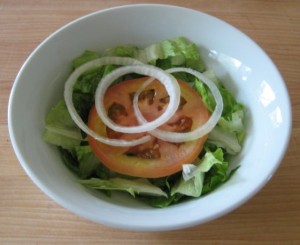
As you can see, my salad WAS composed of about 1 cup of lettuce (usually iceberg) with a slice of tomato (usually unripe), a couple rings of onion, drowned in thousand island or some other commercial type of dressing (to give it some taste :)), all of which halfway filled an average cereal bowl. Does this sound familiar?
When I started eating more raw produce, I found that my old salad paradigm needed a makeover, since I found myself very hungry after eating such a small salad. I saw the amounts of vegetables that other raw food enthusiasts were eating in their salads and made some modifications. Now, I typically eat anywhere from 4 cups of lettuce to one head in my salad on most days. There are many types of lettuce, so for the sake of simplicity I will talk about Romaine lettuce for the remainder of this post.
4 cups of chopped Romaine lettuce is a little less than ½ of a medium to large head, 7 cups is approximately ¾ of a head, and 10 cups is equivalent about one head. Many people over the years have mentioned that they do not eat lettuce, because they have been told that lettuce does not contain many nutrients. Let us take a look at the nutrient content of Romaine lettuce in the amounts that we have mentioned:
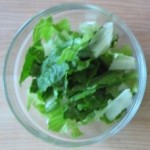
A sampling of nutrients found in one cup of Romaine lettuce:
| 1 cup Romaine lettuce | Adult Daily Values | |
| Calories | 8.0 | |
| Calcium | 15.51 | 1000 – 1200 mg |
| Iron | 0.46 | 8 – 18 mg |
| Zinc | 0.11 | 8 – 11 mg |
| Alpha-linolenic Acid | 0.05 g | |
| Protein | 0.58 g |
A sampling of nutrients found in four cups of Romaine lettuce:
| 4 cups Romaine lettuce | Adult Daily Values | |
| Calories | 32.0 | |
| Calcium | 62.0 | 1000 – 1200 mg |
| Iron | 1.82 | 8 – 18 mg |
| Zinc | 0.43 | 8 – 11 mg |
| Alpha-linolenic Acid | 0.21 g | |
| Protein | 2.31 g |
A sampling of nutrients found in seven cups of Romaine lettuce:
| 7 cups Romaine lettuce | Adult Daily Values | |
| Calories | 56 | |
| Calcium | 108.6 | 1000 – 1200 mg |
| Iron | 3.19 | 8 – 18 mg |
| Zinc | 0.76 | 8 – 11 mg |
| Alpha-linolenic Acid | 0.37 g | |
| Protein | 4.05 g |
A sampling of nutrients found in ten cups of Romaine lettuce:
| 10 cups Romaine lettuce | Adult Daily Values | |
| Calories | 80.0 | |
| Calcium | 155.1 | 1000 – 1200 mg |
| Iron | 4.56 | 8 – 18 mg |
| Zinc | 1.08 | 8 – 11 mg |
| Alpha-linolenic Acid | 0.53 g | |
| Protein | 5.78 g |
As one can see, the nutrient content adds up as one eats more lettuce. In significant amounts, Romaine lettuce can make a significant nutrient contribution to one’s salad, and with the addition of other foods to this salad, the nutrient content will increase. In other words, it all adds up. 🙂
One of the best ways to keep in touch with us is to join our email list. You’ll receive a free copy of Our Top 12 Strategies for Long Term Success on A Raw Plant-Based Diet eBook along with regular information about raw food and plant-based diets and periodic promotions for our classes, events, and other offerings!
What Nutrients are Found in Chia Seeds?
Rick and I have been asked lots of questions over the years about our opinion on specific foods. One of the biggest food questions that we have been asked recently is: “what is the nutrient content of chia seeds?” or some variation on this question. Chia seeds have become very popular in the last couple of years for a number of reasons, including their alpha-linolenic acid content. Alpha-linolenic acid (ALA) is an omega 3 fatty acid that is found in varying amounts in a number of foods, including leafy greens and flax seeds. Here is the ALA content of two teaspoons of chia seeds:
| Chia seeds – 2 teaspoons (8.5 g) | |
| ALA | 1.49 g |
Here are some of the other nutrients found in chia seeds:
| Chia seeds – 2 teaspoons (8.5 g) | |
| Calories | 41.7 |
| Calcium | 53.6 mg |
| Protein | 1.33 g |
| Fat | 2.61 g |
As one can see, a significant percentage (57%) of the fat in chia seeds is alpha-linolenic acid and the calcium content of these seeds is notable at almost 54 mg (for 2 teaspoons and 42 calories), considering that the adult daily value for calcium ranges from 1000 to 1200 mg. Rick and I use chia seeds to thicken our vegetable-based salad dressings, since they work well for this purpose and have a relatively neutral taste in our recipes.
Many people also ask us about the conversion of alpha-linolenic acid to DHA in the human body. Rick covers this topic in depth in our Science of Raw Food Nutrition I course and also has spoken on this subject at various health conferences. Click here to view one of his conference talks on essential fatty acids.
After our last newsletter, many of you made suggestions for future blog topics – thank you! Be looking for a variety of topics on our blog in the coming months, including many of your suggestions. We appreciate your valuable input!
One of the best ways to keep in touch with us is to join our email list. You’ll receive a free copy of Our Top 12 Strategies for Long Term Success on A Raw Plant-Based Diet eBook along with regular information about raw food and plant-based diets and periodic promotions for our classes, events, and other offerings!
Yet Another Green Juice Recipe…
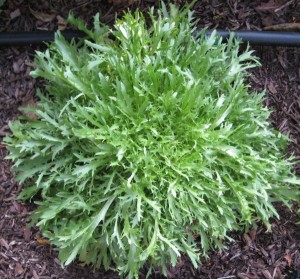
This past weekend Rick and I taught our Science of Raw Food Nutrition I class. As always, it was a joy to teach our information to such a fun and enthusiastic group of students!

Since Rick and I have a LOT of frisée greens (curly endive) growing in our garden now, I made this juice with frisée greens and variety of other popular green juice staples:
5 stalks of celery (12” long)
1 lemon, peeled
1 medium cucumber, 8” long
4 cups frisée greens
½ head romaine lettuce
1 apple
Here are some of the nutrients found in these ingredients:
| Green Juice Ingredients | Adult Daily Values | |
| Calories | 304 | |
| Calcium | 416.4 | 1000 – 1200 mg |
| Iron | 6.9 | 8 – 18 mg |
| Zinc | 3.4 | 8 – 11 mg |
| Magnesium | 164.4 | 310 – 420 mg |
| Potassium | 2990.4 | 4700 mg |
One of the best ways to keep in touch with us is to join our email list. You’ll receive a free copy of Our Top 12 Strategies for Long Term Success on A Raw Plant-Based Diet eBook along with regular information about raw food and plant-based diets and periodic promotions for our classes, events, and other offerings!
Dark Green Juice
 A couple of months ago, I posted a recipe for light green juice composed of celery, cucumber, and lemon. This recipe is a great introduction to green juice since it has a lemony flavor without the bitterness that green juice can have when certain dark leafy green vegetables are used to make the juice. I happen to love the flavor of most leafy greens, so here is a recipe for one of my favorite juices:
A couple of months ago, I posted a recipe for light green juice composed of celery, cucumber, and lemon. This recipe is a great introduction to green juice since it has a lemony flavor without the bitterness that green juice can have when certain dark leafy green vegetables are used to make the juice. I happen to love the flavor of most leafy greens, so here is a recipe for one of my favorite juices:
5 stalks of celery (12” long)
1 lemon, peeled
1 medium cucumber, 8” long
3 cups frisée greens
5 cups dandelion greens
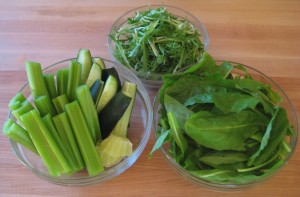
This recipe makes about 3 cups of juice. Here are some of the nutrients found in these ingredients:
| Dark Green Juice Ingredients | Adult Daily Values | |
| Calories | 270 | |
| Calcium | 790.3 | 1000 – 1200 mg |
| Iron | 11.8 | 8 – 18 mg |
| Zinc | 3.4 | 8 – 11 mg |
| Magnesium | 202.6 | 310 – 420 mg |
| Potassium | 2953.1 | 4700 mg |
As one can see, the dandelion greens and frisée greens contribute quite a bit of calcium and iron to this juice when compared to the light green juice recipe from October:
5 stalks of celery (12” long)
1 lemon, peeled
1 medium cucumber, 8” long
This recipe makes about 2 cups of juice. Here are some of the nutrients found in these ingredients:
| Light Green Juice Ingredients | Adult Daily Values | |
| Calories | 120.7 | |
| Calcium | 198.0 | 1000 – 1200 mg |
| Iron | 1.99 | 8 – 18 mg |
| Zinc | 1.07 | 8 – 11 mg |
| Magnesium | 81.05 | 310 – 420 mg |
| Potassium | 1390.39 | 4700 mg |
Dandelion greens and frisée greens are both members of the sunflower plant family (Asteraceae), cucumbers are in the squash family (Cucurbitaceae), celery is a member of the carrot family (Apiaceae), and lemons are in the citrus family (Rutaceae).
One of the best ways to keep in touch with us is to join our email list. You’ll receive a free copy of Our Top 12 Strategies for Long Term Success on A Raw Plant-Based Diet eBook along with regular information about raw food and plant-based diets and periodic promotions for our classes, events, and other offerings!
Welcome to 2012!
We hope that you had a joyful and healthy holiday season! January is always special time of the year for Rick and I. It is a time to rest, regroup, and set our sights on the coming year. It is also a time when we sit down and ask ourselves some formative questions: how have we progressed toward reaching our personal and professional goals and what do we want to achieve in the coming year.
Among many projects this year, we plan to continue our weekly blog posts on various health-related topics and would like to know what you want to see on this blog!
What nutrition and health topics are of interest to you? Are you interested in our travels, raw food science, our classes, and/or gardening? Are you interested in simply presented information or do you want to read about more technical topics such as nutritional biochemistry and physiology? Do you want to hear about the latest peer-reviewed nutrition research articles and clinical outcomes?
There are so many fascinating topics to share with you so we thank you for taking your time to post your questions and topics in the comment section below this blog post. We really appreciate your input!
Holiday Spices and Antioxidants
 Ah, the holidays! Ever since I was a young girl I looked forward to the month of December for its festivities and time spent with family and friends. When I started on my raw food journey in 1990, I designed raw alternatives of my favorite holiday dishes and desserts to share with my loved ones. I included one of my recipes in an earlier blog post – butternut squash pudding, which has become a new holiday tradition in my family.
Ah, the holidays! Ever since I was a young girl I looked forward to the month of December for its festivities and time spent with family and friends. When I started on my raw food journey in 1990, I designed raw alternatives of my favorite holiday dishes and desserts to share with my loved ones. I included one of my recipes in an earlier blog post – butternut squash pudding, which has become a new holiday tradition in my family.
Spices that are often used in holiday recipes have been studied for their antioxidant content. The antioxidant activity of the compounds found in spices and foods has been measured using a system called ORAC, or oxygen radical absorbance capacity. An ORAC value of a food is a measurement of the ability of antioxidants in the food to neutralize free radicals in vitro (in a test tube or laboratory). The ORAC measurement has been questioned by members of the scientific community because it is measured in vitro and not in living organisms (in vivo). A free radical is a molecule with an unpaired electron that can cause damage to cells in our body.
Much is currently known about nutrition, and there is much that we have yet to learn. Our scientific, clinical, and experiential knowledge about nutrition is incomplete and will continue to increase as our inquiry in this area progresses. I personally would be interested to see the ORAC values of foods measured in humans and other living beings (in vivo). Hopefully this information will be available sometime in the future.
Here is a sampling of holiday spices and their respective ORAC values:
| Total ORAC value (µmol TE/100 g) | |
| Cinnamon, ground | 131,420 |
| Cloves, ground | 290,283 |
| Ginger, ground | 39,041 |
| Nutmeg, ground | 69,640 |
I was amazed to see the high ORAC value of these spices, especially when compared to popular high ORAC value foods, such as:
| Blackberries | 5,905 |
| Blueberries | 4,669 |
| Wild blueberries | 9,621 |
| Raspberries | 5,065 |
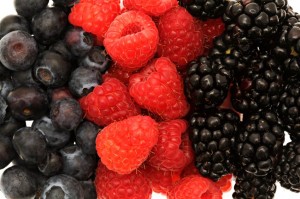
One might think, based on this information, that cinnamon, cloves, ginger, and nutmeg are superior sources of antioxidant activity to the fruits stated above. The spices are superior, PER 100 GRAMS. Please note that ORAC values for foods are reported per 100 grams.
But how much of each of these spices do we actually consume in a serving? Let’s do some simple calculations using ground cloves as an example. A typical 9” round pumpkin pie recipe calls for ¼ teaspoon of ground cloves. ¼ teaspoon of ground cloves weighs approximately 1 gram. The ORAC value for 100 grams of ground cloves is 290,283. If we divide this number by 100, we get a value of almost 2903 for 1 g of ground cloves in a whole pumpkin pie.
Now, there are generally 8 pieces in an average pumpkin pie. So, if we divide 2903 by 8 we get a value of about 363 for the 0.125 grams of ground cloves in one piece of pumpkin pie. Given that ORAC values are tested and reported per 100 grams of food, I cannot say that 363 is THE ORAC value for the 0.125 grams of ground cloves found in the piece of pie. I would need actual studies to confirm or deny this number, since other possible contributory factors must be taken into account. The bottom line here is that one needs to consider nutritional information, such as ORAC values, in the context of the amounts that one actually eats.
For comparison with another type of food, let’s consider the ORAC value and the amount of blackberries in one serving. The ORAC value for 100 g of blackberries is 5,905. One cup of blackberries weighs 144 g, so the ORAC value for 100 g of blackberries is very roughly equivalent to ⅔ of a cup, which could be considered a small serving of blackberries. Whenever I eat blackberries, I usually eat more than ⅔ cup, as do many raw food enthusiasts that I know.
Looking at the actual serving sizes of ground cloves and blackberries, one can strongly question the ORAC superiority of ground cloves to blackberries, or any of the other fruits shown in the table above. Of course, we would need more information on the antioxidant activity in the amount of cloves found in a piece of pumpkin pie to make a more definitive statement.
I would love to see researchers take into account such information when doing their studies, since this would make their information more meaningful and applicable to daily life. In the meantime, we must employ our skills of critical thinking when we hear such pieces of information out of context. Critical thinking is essential in many aspects of life, including the realm of nutrition information. We will address critical thinking in future blog posts.
For those of you interested in delving more deeply into this subject, here are some interesting points to note:
- The ORAC values reported are for dried and ground spices. I am curious to know if/how the ORAC value would differ in the fresh versions of these spices, especially ginger, since it is a naturally water-rich root.
- ORAC values are measured by weight, per 100 grams. I would like to see an ORAC value comparison per calorie, and as stated earlier, per serving size.
- If the food in question is part of a recipe or processed food, what other ingredients and/or processing methods can affect the ORAC value of that food?
For more information on the ORAC values of various foods, please visit: USDA nutrient database and USDA Database for the Oxygen Radical Absorbance Capacity (ORAC) of Selected Foods, Release 2 – May 2010
Best wishes for a happy and healthy new year!
One of the best ways to keep in touch with us is to join our email list. You’ll receive a free copy of Our Top 12 Strategies for Long Term Success on A Raw Plant-Based Diet eBook along with regular information about raw food and plant-based diets and periodic promotions for our classes, events, and other offerings!
December Limes
Last week, nighttime temperatures dropped into the low 30s in our area of northern California. It is rare to have freezing temperatures here, so when the outside temperature nears 32º F, residents of this area do their best to keep their freeze-sensitive plants warm. A good example of such plants would be citrus, including limes. I love the tangy flavor of limes. One of our neighbors has several citrus plants, including limes, so I was thrilled when our very generous neighbor came over with a basket filled with limes for us. Here is a picture of some of them:
Limes are famous for their green color, which actually changes to a more yellow color as they ripen. Limes have that fabulous tangy flavor when they are still green, which tends to mellow somewhat as they ripen. Our neighbor harvested these limes when they had not fully ripened to keep them from being harmed by the cold weather.
Limes are well known for their vitamin C content, as are lemons and oranges and other members of the citrus family. I was surprised to see the calcium and iron content of limes, which per calorie, is notable.
Here are some of the nutrition highlights of limes:
| 3 peeled limes | |
| Calories | 60 |
| Vitamin C | 58.5 mg |
| Calcium | 66 mg |
| Iron | 1.21 mg |
For comparison purposes, here are some of the nutrition highlights of lemons:
| 3 peeled lemons | |
| Calories | 50 |
| Vitamin C | 92.2 mg |
| Calcium | 45 mg |
| Iron | 1.04 mg |
Per calorie, lemons have more vitamin C, limes have more calcium, and both have a similar amount of iron.
Here is a photo of an almost-ripe lime (left) and lemon (right) placed on a dark red background for contrast:
Best of health!
Dr. Karin Dina, D.C.
A Surprising Source of Iron
Once in a while, I come across a nutrient dense food that is not popularly known for its nutrient content. Recently when doing some research on plant sources of iron, I found Jerusalem artichokes. This interesting root (or more specifically, tuber) is a member of the sunflower family plant family, along with lettuce, dandelion greens, yacón, and of course, sunflower seeds.
Last spring, a friend encouraged us to grow Jerusalem artichokes in our backyard garden. Given that they have a tendency to spread wherever they are planted, we planted them in a compost/soil mixture in a barrel planter on our backyard deck. We are happy to report that our cultivation efforts were successful and have recently harvested numerous Jerusalem artichokes. Here is a sampling of our harvest:
The best way that I can describe the taste of Jerusalem artichokes is mildly sweet, similar to yacón root and jicama. As far as nutrient content is concerned, I was impressed to see the iron content of 1 cup of Jerusalem artichoke slices:
| 1 cup sliced Jerusalem artichoke (150 g) | Adult Daily Values | |
| Calories | 110 | |
| Vitamin B3 (Niacin) | 1.93 mg | 14 – 16 mg |
| Iron | 5 mg | 8 – 18 mg |
| Potassium | 643 mg | 4700 mg |
One of the best ways to keep in touch with us is to join our email list. You’ll receive a free copy of Our Top 12 Strategies for Long Term Success on A Raw Plant-Based Diet eBook along with regular information about raw food and plant-based diets and periodic promotions for our classes, events, and other offerings!
Thanksgiving at the True North Health Center and Simple Salad Dressings
Hope you all had an enjoyable Thanksgiving, we sure did! We are thankful to have enjoyed thanksgiving dinner at the True North Health Center with friends and colleagues, and we even saw a student of ours there! Here is a picture of the salad course of the meal:
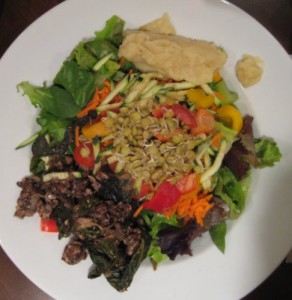 This salad and the other dishes were amazing, not surprisingly. The ingredients were simple, yet delicious, the way that we like it. We do eat quite a bit of salad, given that salads are a quick and easy way to eat a good amount of vegetables. Salads can be as simple or complex as one wants and as far as dressings are concerned, the sky is the limit. Here is an example of the type of salad that Rick and I eat often:
This salad and the other dishes were amazing, not surprisingly. The ingredients were simple, yet delicious, the way that we like it. We do eat quite a bit of salad, given that salads are a quick and easy way to eat a good amount of vegetables. Salads can be as simple or complex as one wants and as far as dressings are concerned, the sky is the limit. Here is an example of the type of salad that Rick and I eat often:
When we are traveling, salad dressings can be a challenge to make, especially if we do not have a blender with us, which is most of the time. I know that there are many types of small travel-friendly blenders, which can come in handy. However, when we are blenderless, we have a variety of simple dressings that require minimal preparation and taste great.
One example is avocado mixed with tomato, another is lemon, orange, or pomegranate juice squeezed on the salad, and another is some type of nut butter mixed with the juice of lemon, lime or orange. One of my favorites is sesame tahini mixed with fresh squeezed lemon juice over a giant salad. Sometimes I add some type of chopped culinary herb to add some flavor.
Raw food dressings do not have to be complicated and appliances are most certainly optional, given the variety of dressings one can make without them. Knowledge of how to make simple dressings is especially helpful when traveling and appliances are in short supply.
What easy salad dressings have you made?
One of the best ways to keep in touch with us is to join our email list. You’ll receive a free copy of Our Top 12 Strategies for Long Term Success on A Raw Plant-Based Diet eBook along with regular information about raw food and plant-based diets and periodic promotions for our classes, events, and other offerings!

